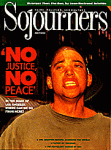James Douglass has a gift for making the Bible come alive and become relevant concerning the vital issues of our times, especially the problem of violence and the possibility for an alternative. Through Douglass' recent book, The Nonviolent Coming of God, we get to know Jesus better, even intimately. Jesus - hardly recognizable within our violent culture - stands before us, with us as friend and companion, nonviolent agitator, and loving and confrontational prophet.
Douglass shares a key to understanding the ministry of Jesus: the destruction of Sepphoris, a city four miles from Jesus' home town of Nazareth. Douglass describes Rome's sophisticated means for maintaining control of its subjects in distant territories. The empire worked with client kings amenable to Rome's economic and political interests. It also appointed the high priest -- the highest religious authority in Judaism -- who maintained his position by pleasing Rome.
Religious authorities often not only defended the interests of Rome, they also helped maintain an economic and cultural order that victimized the vast majority of people who were poor. Not surprising, rebellions were common and reflected resentments that were both anti-imperial (against Roman occupation) and anti-Jewish elite (against what were seen as Jewish collaborators).
Rome discouraged such rebellions by employing sophisticated psychological warfare techniques, most notably crucifixion. People considered dangerous were crucified. Public execution of "dissidents" -- whose bodies were left to rot and be eaten by wild animals -- was a powerful deterrent.
When client kings, appointed priests, and selective terror failed to deter would-be rebels, Rome sent in its legions and destroyed entire cities. This, according to Douglass, was the fate of Sepphoris.
Four years before Jesus' birth, Rome's client King Herod died, prompting a rebellion of people from Sepphoris and nearby Nazareth. The people took control of the royal palace and local arsenal, but their success was short-lived. Hoards of Roman soldiers were sent in, the city was burned to the ground, and many men, women, and children were killed. Douglass believes that some of the "maimed and lame" we encounter in the gospel stories were survivors of this time. After burning Sepphoris, Rome crucified more than 2,000 suspected agitators throughout Palestine.
THE IMPORTANCE of Sepphoris, Douglass says, is that "we cannot understand Jesus' alternative vision of the kingdom of God, or the reign of a new humanity, apart from its life setting of an imperial power that oppressed and threatened to annihilate Jesus' people." More particular, "Jesus' consciousness of Sepphoris would have deepened into fears for Jerusalem."
Knowledge of Sepphoris profoundly shaped Jesus' ministry. He resisted Rome's oppressive power and challenged unjust religious authority, but he also rejected the violent means of resistance offered by those who rebelled. He saw his people headed for destruction (therefore his many warnings about and his weeping over Jerusalem), and he offered an alternative to that destruction - the nonviolent coming of God.
The backdrop for Jesus' ministry was his hope to avoid the impending destruction of Israel by Rome. The choice was embracing the nonviolent coming of God or destruction. "Today," Douglass notes, "Jerusalem has become the world...Be thus reborn as a global people by your Nonviolent God, or be annihilated by a desert storm beyond the imagination of presidents and generals."
The United States, Douglass notes, has built on aspects of Rome's psychological warfare through its strategy of "low-intensity conflict," and has also threatened destruction of the world through nuclear weapons. "Our nuclear weapons," he writes, "target the world's poor, and ultimately the earth itself, for first-world economic interests."
Douglass' book is strengthened by the integrity of his and his community's witness against the forces that threaten the world with destruction today. He writes in hopes that we will recognize the importance of our choices:
The trains running past our home in Birmingham continue to bring the end of the world - Department of Defense boxcars with their bright orange "Explosives A" placards bearing Trident-2 missile propellants on their way to Kings Bay, Georgia. And beside the Birmingham tracks we see the end of the world now - decaying houses and hospitals, schools without resources, children pushing drugs, the growth of gang violence...evils whose remedies are being carried down the tracks, their funds having been absorbed by the missiles in the boxcars. Will we make the connection?
Douglass, who is filled with hope rooted in faith, reminds us that the nonviolent coming of God "is no further away than the hands God has given us."
Jack Nelson-Pallmeyer was a teacher and writer living in Minneapolis when this article appeared. He had authored most recently Brave New World Order (Orbis Books, 1992).
The Nonviolent Coming of God. By James Douglass. Orbis Books, 1991. $13.95 (paper).

Got something to say about what you're reading? We value your feedback!
